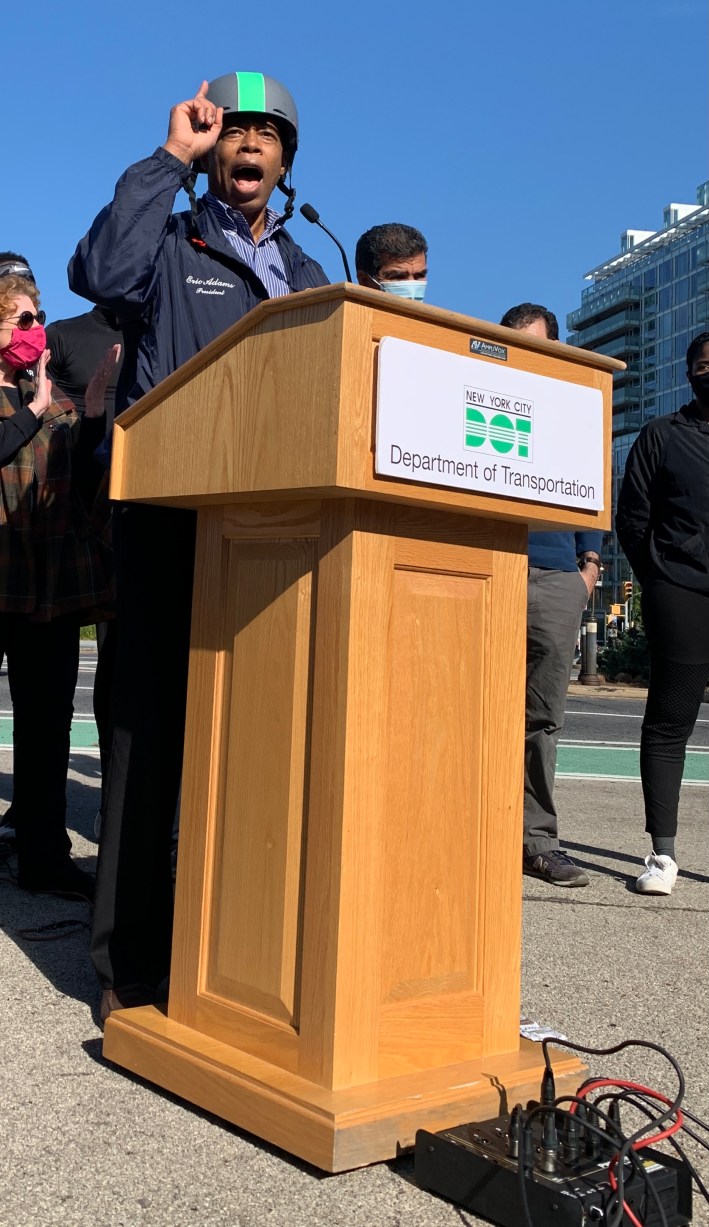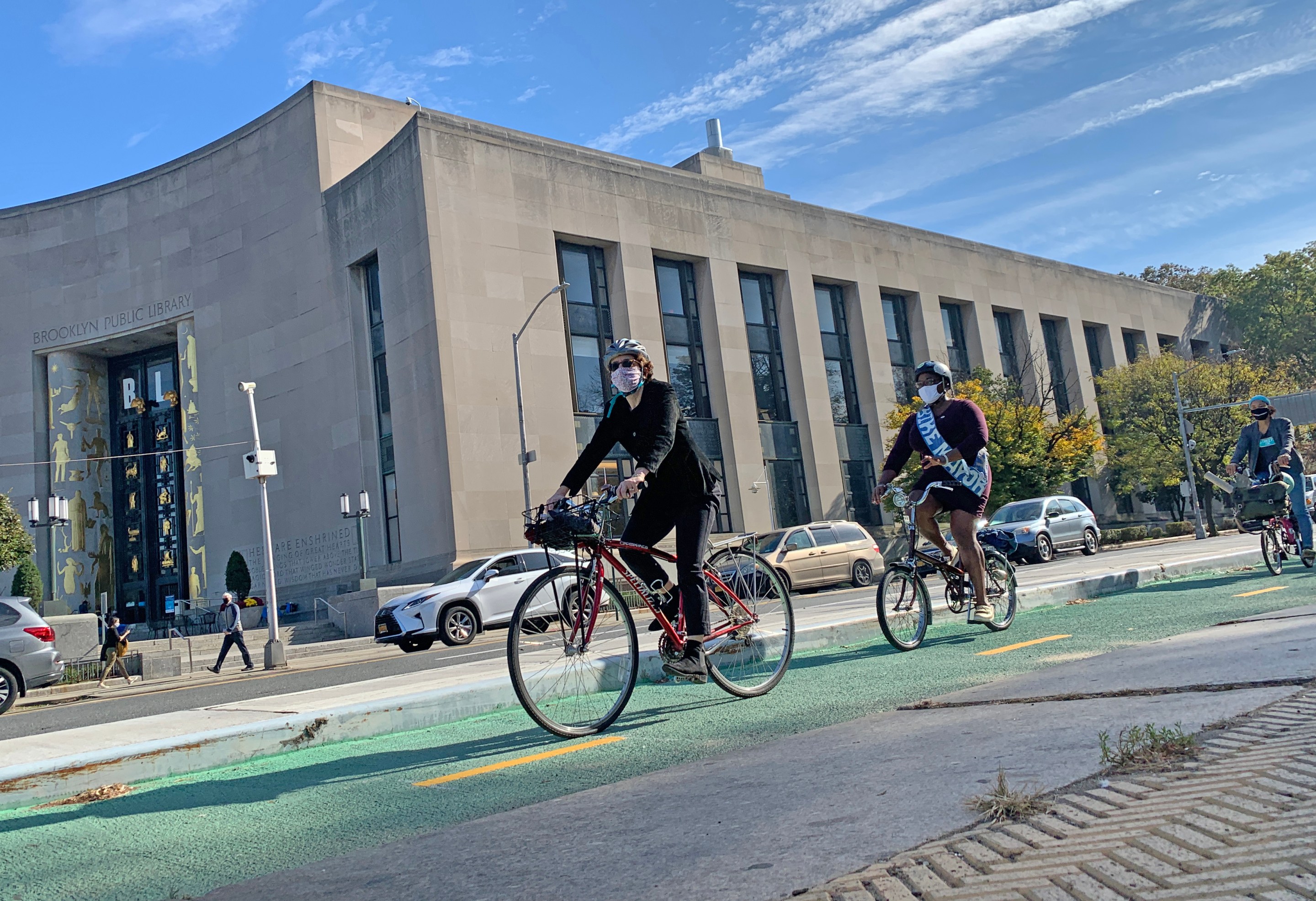Let them eat paint.
At a ceremonial ribbon-cutting of a new protected bike lane on Flatbush Avenue on Thursday, DOT Commissioner Polly Trottenberg shrugged off a question suggesting that the city's many unprotected bike lanes don't make cyclists feel comfortable.
"It's a pretty good ride between here and Jay Street — you've got Vanderbilt to Bergen, so it's pretty good," Trottenberg said at the press conference in Grand Army Plaza at the northern end of Prospect Park. "It is [comfortable] for me."
The puzzling answer from Trottenberg, an experienced cyclist, came in response to a question about the new lane on Flatbush Avenue between Grand Army Plaza and Empire Boulevard, which, the DOT said, "links Downtown Brooklyn and key East River crossings with Central Brooklyn neighborhoods of Prospect-Lefferts Gardens, Flatbush, East Flatbush and beyond." But from Grand Army Plaza to Downtown Brooklyn, there are no protected bike lanes — only painted lanes and sharrowed roads.
Trottenberg said when she rides from her Park Slope home towards the bridges, she usually takes Vanderbilt Avenue to Bergen Street — neither of which have protected bike lanes. She ended her answer by gesturing to the many cycling advocates who attended the event, saying, "Maybe people have different opinions."

Indeed, they did. Bicycling consultant and advocate Courtney Williams, who tweets as the Brown Bike Girl, stood up for her less-experienced constituents.
"A painted lane is technically not a protected lane," said Williams, who was recently named a "People's Bike Mayor" by the Dutch group BYCS. "People forget to remember that we are supposed to plan this city for those who are the most-vulnerable and least-experienced. Right now, there are a whole lot more inexperienced people who need greater protection in a physical sense, as is the case on Flatbush Avenue."
Trottenberg's remarks about her level of comfort in an unprotected bike lane were particularly discordant, given that when she is typically challenged about the pace at which her agency builds protected bike lanes, she often admits that there is more to be done, but points out that the New York City DOT is considered a leader nationally.
And, indeed, in a different portion of the press conference, she ticked off the many accomplishments of her agency in this difficult pandemic year, including the mayor's open restaurants and open streets program, building 17 miles of dedicated bus lanes and remaining on target to complete 25 miles of protected bike lane by the end of the year — which would be the most protected bike lanes the city has ever built in a single calendar year.
Nonetheless, the press conference — to celebrate the worthy protected bike lane project along Flatbush Avenue — itself ended up becoming a symbol of the inequity of the current allocation of critical safety infrastructure and how much needs to be done to ensure safety for all New Yorkers.
Many speakers — including Trottenberg — noted that Thursday's event came just a few days after an event marking the 10-year anniversary of the construction of a protected bike lane on the tony Park Slope side of Prospect Park. Brooklyn Borough President Eric Adams called the 10-year gap a fitting symbol of the haves and have nots.
"Multi-million dollar homes and tenement buildings, they all want the same things. We can't have 10-year gaps in allowing the green pavement of cycling to send the right statement that it is a green light to move ahead and use our streets in a safe fashion," said Adams. "It is unacceptable how dangerous it is to ride in this city."
City Council Member Brad Lander, who was part of the fight to get the Prospect Park West bike lane a decade ago, added that "COVID is telling us" to build a city "with more transportation alternatives, with more bike lanes, with more pedestrian plazas, done in a way that recognizes the fundamental equality of all New Yorkers and insists on building a safer and more livable city for everyone."
One newbie cyclist at the press conference was baffled by the notion that unprotected infrastructure — mere paint — is enough to make riders feel comfortable.
"It's definitely not as comfortable without a protected bike lane," said Kori Massey, a resident of Bedford-Stuyvesant who started riding in the city only in June. "I know for a fact that not all drivers are paying attention, whether it be a distraction like a phone or whatever. So I definitely feel more comfortable with a protective allotted space they have to respect, as opposed to just riding in the street."
Studies show that painted bike lanes are far less safe than protected bike lanes. Other studies have shown that motorists pass much closer to cyclists on roadways with painted bike lanes.
And in surveys, people frequently say that the most important reason for not using a bicycle is that they feel unsafe on streets — a phenomenon that Portland Bicycle Coordinator Roger Geller once dubbed the “interested, but concerned” cohort in a famous 2006 white paper. One of the stated goals of the city's own Vision Zero program, of course, is to ensure safety for cyclists from age 8 to 80.
On the plus side, Thursday's ribbon-cutting in Grand Army Plaza was followed by another on Fourth Avenue nearby, which now has a protected bike lane from 65th Street at the southern edge of Sunset Park to Atlantic Avenue on the edge of Downtown Brooklyn, roughly four miles away.
The new lanes celebrated on Thursday come as the city is experiencing a second exceptionally bloody year for cyclists in a row, with 20 dying so far this year, compared with 29 all of last year — a year that was a high during the de Blasio administration's tenure.
— with Gersh Kuntzman






